 |
Prince Edward Island 1970 passenger issue (1969 base). While it may not look like much, this plate may be one of the crown jewels of my collection. Prince Edward Island issued 500 sets of these experimental reflective plates (numbered 30-001 through 30-500) at the beginning of 1969. They held up spectacularly poorly to the brutal winters of the island, and were gradually replaced with standard non-reflective plates between 1970 and 1972. For this reason, very few survived in decent condition, if at all. Yet, somehow I tracked one down. Keith Marvin (ALPCA #282) wrote a great article about these plates in the April 1997 ALPCA Newsletter, without which I probably wouldn't even have known about these plates. Keep meaning to write and thank him... |
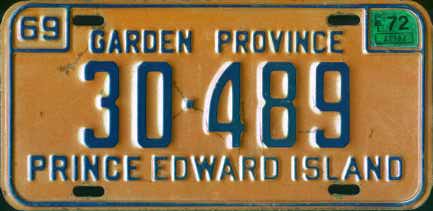 |
Prince Edward Island 1972 passenger issue (1969 base). Included purely for bragging rights - yes, I have two of these experimental reflective plates. Where the first one (above) was early in the series (25th plate produced), this one was late in the series (11 from the end.) This plate stood up exceptionally well, considering that it was used through 1972 and, presumably, never replaced with a standard non-reflective plate. |
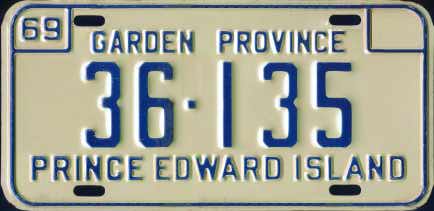 |
Prince Edward Island 1969 passenger issue. This dark blue on tan issue was the standard Prince Edward Island 1969 issue, which tended to stand up much better to the elements on the island. These plates were used without stickers through 1969 and with stickers until the end of 1972. Numbering on this style of plate began at 30-501, where the experimental reflective issues left off. |
 |
Prince Edward Island 1973 passenger issue. This plate was released at the end of 1972 to replace the 1969 base. It features a graphic of one of the Fathers of Confederation who met in Charlottetown, PEI to work out the details of the Confederation of Canada. It also instituted the slogan "The Place To Be...In '73". Apparently, ALPCA agreed and awarded this plate their Plate of the Year honors for 1973. These plates were used through the end of 1975 with stickers. Presumably, PEI was still "The Place To Be" in those years, as well. |
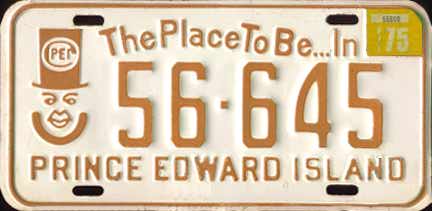 |
Prince Edward Island 1975 passenger issue. Another issue on the '73 base, this plate carries a 1975 sticker. This obviously throws off the rhyme scheme for the slogan, but it remains catchy nonetheless. |
 |
Prince Edward Island 1977 passenger issue. These new plates were first issued in 1976 and feature a raised sticker box to the right of the serial with a debossed "76" in its center. These plates used the "Seat Belts Save" slogan and were valid from 1976 through the end of 1980 with stickers. The "77" validation sticker celebrates the Boy Scout Jamboree held in the province that year. |
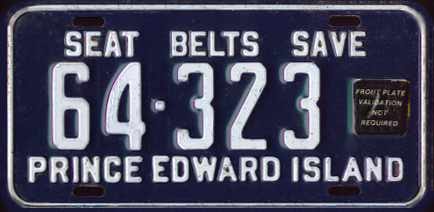 |
Prince Edward Island undated passenger issue (1976 base). With the 1980 expiration, Prince Edward Island planned to begin issuing only a single validation sticker to motorists, to be placed on the rear plate of the vehicle. As a result, renewals in 1980 were issued one "1980" sticker for the rear plate and one of these "Front Plate Validation Not Required" stickers for the front plate. The theory was that stickers could be used singly from there on in. As it happened, however, these plates were all replaced after the 1980 expiration, so it turned out to be a moot point (not to mention almost certainly being more expensive than just issuing everyone two "1980" stickers). Oh well. |
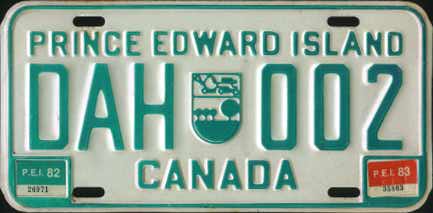 |
Prince Edward Island 1982/83 passenger issue. This plate design, featuring the provencial crest at the center and using an ABC-123 format was first issued in 1981. Early issues of the plate have a lightly debossed "81" in the lower right sticker box. The original serial format used the letters A through R (except F and Q) as the first letter and "A" as the second, although this sequence changed over the years. These plates remain valid today with stickers, although they are rarely seen due to their age and tendency towards rusting. |
 |
Prince Edward Island 1985/86 passenger issue. Continuation of the provincial crest issue, additional letters were added to the series as needed, so later issues had letters other than "A" in the center. There were several other minor variations on this base through this period, including plates with squared-off corners, bolt holes instead of slots, and metal stock variations. |
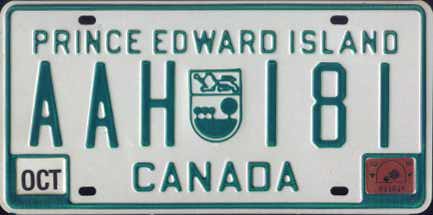 |
Prince Edward Island 1989 passenger issue. Variation of the above plate, this was a later-period plate in this series using narrower dies for the serial. Plates of this sort were produced in Quebec, as opposed to most PEI plates, which are produced by Waldale, Ltd. in Nova Scotia. These plates were made of aluminum, as opposed to older issues which were steel, so these are the most likely of the 1982-base PEI plates to actually be seen on the road in decent shape these days. The 1989 sticker, like the 1977, again commemorated the Boy Scout Jamboree held in the province that year. |
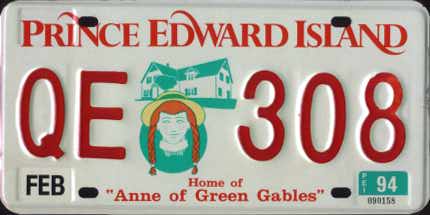 |
Prince Edward Island 1994 passenger issue. This graphic plate was first issued in 1993 and commemorates the home of "Anne of Green Gables", the fictional character in L.M. Montgomery's novel of the same name. Montgomery was born and raised in Cavendish, PEI and set her novel there. These plates were initially issued in an AB-123 format, with the first letter being a county code, "K", "Q" or "P" for Kings, Queens or Prince counties. Early plates in the series were produced by HiSigns in Alberta and contained an odd debossed sticker well at the top left, under the "Pri" part of "Prince." Alberta plates use this three-well system, which was likely carried over when HiSigns made these plates. This series was issued through the end of 1996 but remains valid with stickers. |
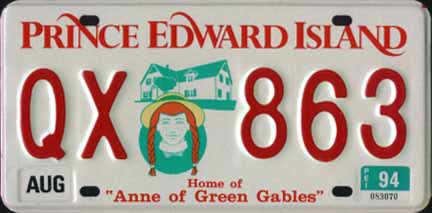 |
Prince Edward Island 1994 passenger issue. Second revision of this plate, later issues were made by Waldale in Nova Scotia and are more or less identical to the previous plates aside from the pesky top-left sticker well being removed. |
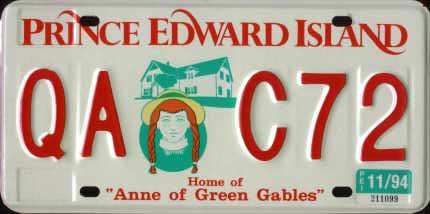 |
Prince Edward Island 1994 passenger issue. One of a couple overflow formats for Queens county. When the Qx-123 format was exhausted, plates in the QA-B23 and Q1-234 formats were used. Queens county was the only one of the three to have this problem, as the other two counties are not large enough to have overrun their allocations. Again, different manufacturers seemed to make these plates, as some of them (like this one) had the upper left sticker well and some did not. |
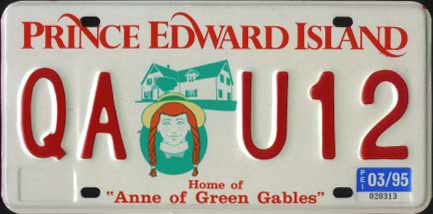 |
Prince Edward Island 1995 passenger issue. Another QA-B12 series plate, without the sticker well at the top this time. These were issued for a while (I've seen them as high up as the QC series) before county coding was abandoned as impractical. |
 |
Prince Edward Island 1995 passenger issue. The other Queens county overflow format, passenger vehicles also received these Q1-234 format plates after the Qx-123 format was exhausted. This was obviously a short-lived solution, however, only allowing for 9,000 plates to be issued. |
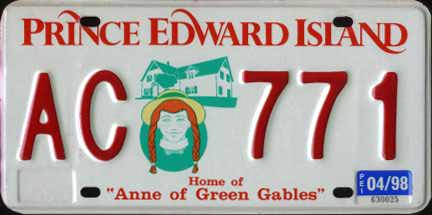 |
Prince Edward Island 1998 passenger issue. Another overrun plate, near the end of the series of these plates, non-coded plates starting with "A" were issued to passenger vehicles. Plates from the "Tx" series, intended as truck plates, were also issued to passenger vehicles during this time to allow for enough plates to bridge the gap to the next issue. |
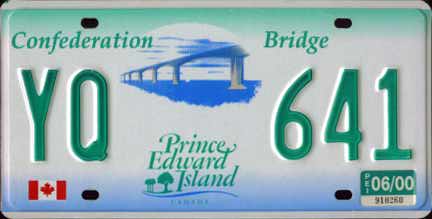 |
Prince Edward Island 2000 passenger issue. This new graphic issue is one of two different baseplates currently being issued by Prince Edward Island. This plate commemorates the 1997 opening of the Confederation Bridge, a 12-mile span of highway connecting Prince Edward Island to the Canadian mainland at Cape Tormentine, New Brunswick. These plates are issued in an AB-123 format, but without the county coding used on the Anne plates. Initial plates were supposedly issued starting with the Z series, then back through Y and X, although I'm not sure how strictly this order was followed. Plates were also issued in the V, U and R series as additional serials became necessary. |
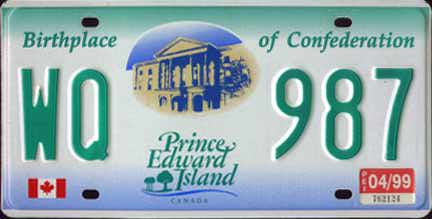 |
Prince Edward Island 1999 passenger issue. This plate is an optional issue, being issued at the same time as the Confederation Bridge plate above. This "Birthplace of Confederation" plate features a graphic of the Province House in Charlottetown where the confederation of Canada was first discussed and debated. These plates were initially issued only in the W series, with more motorists opting for the Bridge plate. |
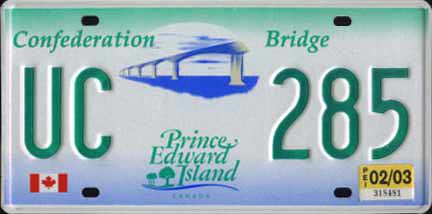 |
Prince Edward Island 2003 passenger issue. This is a recently issued re-design of the Bridge plate. The differences are pretty subtle and include a darker shade of green for the slogan and province name, darker shade of blue in the water and on the bridge, smoothed-out bottom edge to the water, lighter cloud cover, and the absence of the small sailboat under the bridge. Guess after six years, he finally made it out of the shot. This change affected the Vx series of plates, as well as some, but not all, the Ux series. These plates at this point can just about officially be said to be issued in No Discernable Order. |
 |
Prince Edward Island 2003 passenger issue. Not to be left out, the Birthplace of Confederation plate also received a recent "update," starting at some point within the N series, which followed the W series. N being the next available letter not already used by Bridge or older, still-valid Anne plates. Anyway, the subtle differences between this plate and the original include a lighter shade of green for the slogan and province name, a brighter shade of blue in the house graphic, a less distinct tan color to the house, and a generally more "blurred" look to the graphic. Please don't ask me why any of this was necessary. |
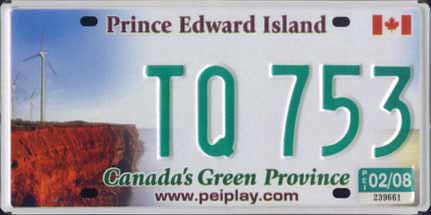 |
Prince Edward Island 2008 passenger issue. Starting in 2007, Prince Edward Island began issuing new plates featuring a graphic of electric-producing wind turbines found on the island's coast. The plate also adds the new "Canada's Green Province" slogan and the provincial tourism website address. At the time of this plate's release, there was a stated purpose of re-plating all older issues previous to the bridge/house issues (all 1981-era green plates and Anne plates), due in particular to the deterioriation of the older green plates. The province seemed to have underestimated the dedication of some registrants to keeping their old plates and has apparently abandoned this re-plate plan due to public resistance. As a result, all 1981-present plates remain valid and this new issue is only given to new registrants or by request. |
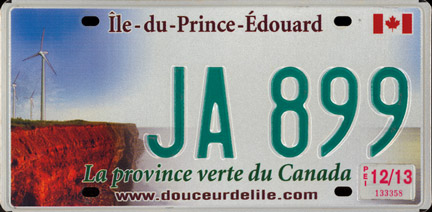 |
Prince Edward Island 2013 passenger issue. Shortly after the release of the wind turbine graphic, PEI released an alternate, French-language version of the plate. The issue is identical graphically, but translates the province name, slogan and website address (presumably to a French-language version of the tourism site). These plates were not issued in great numbers and only exist in the JA-prefix series. |
 |
Prince Edward Island 2011 passenger issue. In 2010, upon reaching the end of available passenger registration numbers in the AB-123 format between the Anne, Bridge, House and Turbine bases, a reversed 123-AB format was introduced. At the same time, the baseplate was tweaked slightly, swapping the positions of the Canadian flag and the sticker box on the righthand corners and adding a barcode to the bottom right. |
 |
Prince Edward Island undated passenger issue (exp 2015). Starting in September 2013, Prince Edward Island began issuing a new graphic baseplate which will eventually replace all currently valid bases from 1981 forward. This plate features a graphic of Confederation House and the slogan Birthplace of Conferation, with the Canadian and provincial flags at bottom and the provincial seal as the separator in the serial, borrowing elements from several previous issues. |
Additional P.E.I. information provided by: Andrew Osborne
























